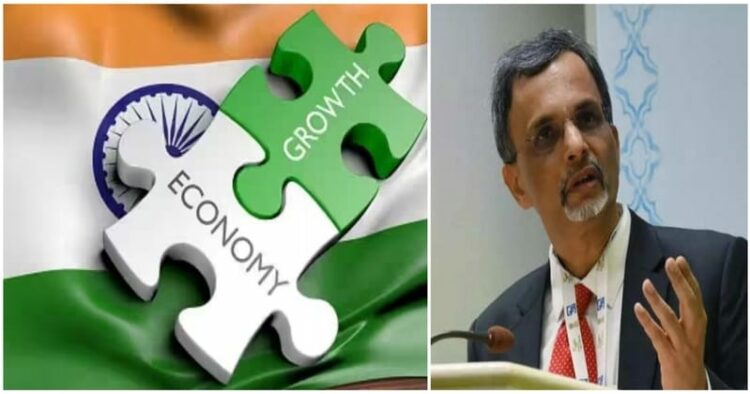Chief Economic Advisor Dr V Anantha Nageswaran on June 10 lauded the estimated 7.2 per cent real GDP growth in 2022-23 and expressed confidence that when the final numbers for the fiscal are frozen in early 2026, the growth will be higher.
Speaking at an event organised by the Bharat Chamber of Commerce here, Anantha Nageswaran said 7.2 per cent GDP growth is “heartening achievement for the Government and economy”. “It is efforts of people like you more than the Government that gave us 7.2 per cent real GDP growth in FY 23 following the 9.1 per cent in FY 22,” he said.
Anantha Nageswaran said India’s GDP growth estimates are presented six times and “the final estimate for FY 23 will actually be with us in January-February 2026”.
“And my expectation and belief is that when the final number for FY 23 is frozen in February 2026, the number will be more than 7.2 per cent,” he said.
According to official data released earlier this week, India’s economy grew by 6.1 per cent in the January-March quarter of 2022-23, and the annual growth rate was 7.2 per cent.
As per the provisional estimates released by the National Statistical Office (NSO) recently, real GDP growth for 2022-23 stood at 7.2 per cent, higher than the 7 per cent projected earlier.
Anantha Nageswaran said this is the first reliable estimate of GDP growth and “as more and more data become available, further revision will be for upside from 7.2 per cent.”
It is to be noted that, according to World Economic Forum (WEF) President Borge Brende, India’s economy is experiencing the “famous snowball effect” that will generate additional investments and jobs.
India is predicted to have the greatest growth among the world’s major economies this year.
WEF President visited New Delhi on May 24-25 to attend the Confederation of Indian Industry’s (CII) Annual Session 2023. The theme for the Annual Session is “Future Frontiers: Competitiveness, Technology, Sustainability, and Internationalization”. He spoke with stakeholders about ongoing partnerships and India’s G20 chairmanship. He interacted with business leaders in addition to several Union ministers.
While interacting with media, he stated, “There have been reforms that have led to less red tape, a better climate for investments and also the digital revolution is really happening in India”. Brende emphasised that while he is “very bullish and optimistic” about the trajectory of the country’s economy, he is not as upbeat about global growth.
India is one of the leading economies with the fastest growth rates in the world and is currently holding the G20 presidency. For many years, WEF has worked closely with India. WEF President said, “When the snowball starts to roll, it gets bigger and bigger, and that is what is happening with the Indian economy.”
At this growth rate, India will be able to cater for the young population. He stated, “India’s growth will lead to more investments, more jobs… it will be an exponential growth in the coming years, and you will see a situation where more poverty is eradicated, and more opportunities are there for young people”.
Brende advised developing nations to learn from India, “I think that nations in the developing world have something to learn from India. India is the largest democracy in the world, and it is also an open society with entrepreneurs and innovators and free speech”.
He further emphasised that India has a thriving startup environment that is more diverse than any other developing nation. Brende added that this could also inspire other countries.
(with inputs from ANI)




















Comments